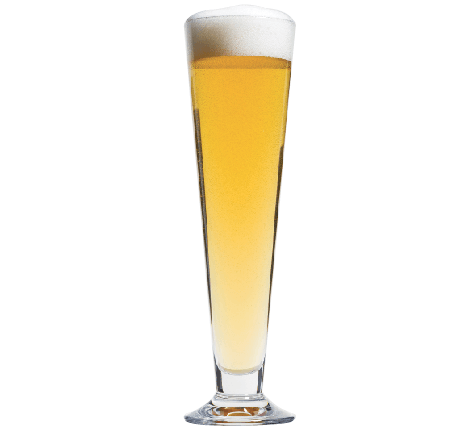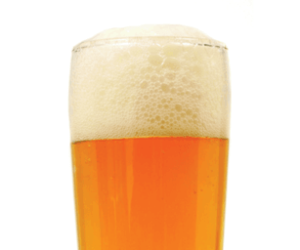German Pils
Pils
(5 gallon/19 L, all-grain)
OG = 1.048 FG = 1.011
IBU = 45 SRM = 3.4 ABV = 4.9%
This beer is hearty but very drinkable. It is hop-spicy upfront, with a solid mouthfeel and a crisp finish. Many German breweries nowadays make a Pils with much less hop character and a lower gravity than specified here, but this recipe is closer to the original guidelines for making this beer as it might have been brewed in the 19th century.
Ingredients
8.8 lbs. (4 kg) Pilsner malt
15.5 oz. (440 g) Carapils®/Carafoam® malt
6 AAU Tettnanger hops (60 min.) (1.5 oz./43 g at 4% alpha acids)
5.2 AAU Spalt hops (30 min.) (1.3 oz./36 g at 4% alpha acids)
2.6 AAU Mittelfrüh hops (5 min.) (0.6 oz./18 g at 4.25% alpha acids)
Wyeast 2247 (European Lager) or White Labs WLP830 (German Lager) or Saflager S-189 yeast
7⁄8 cup corn sugar (if priming)
Step by Step
This recipe uses a multi-step infusion mash. Dough in at around 104 °F (40 °C) for a hydration rest of 15 minutes. Raise the temperature to 122 °F (50 °C) for a protein rest of 15 minutes. Raise the temperature to 149 °F (65 °C) for a beta amylase rest of 30 minutes. Raise the temperature to 162 °F (72 °C) for an alpha amylase rest of 30 minutes. Raise temperature to 169 °F (76 °C) for the mash-out. Recirculate wort then begin sparge.
Boil for 75 minutes, adding hops as indicated. At the end of the boil, turn off heat and whirlpool for 15 minutes. Heat-exchange to the high end of the temperature range for the selected yeast. As soon as primary fermentation is vigorous, reduce the tank temperature to the low end of the yeast’s temperature range. After 7 additional days, give the beer a diacetyl rest by raising the tank temperature to 66 °F (19 °C) and hold it there for about 2 days. Rack and reduce the beer temperature for lagering by 2 °F (1 °C ) a day until reaching 31 °F (–1 °C) or close to it, equipment permitting. The lagering temperature should definitely not be higher than 38 °F (3.5 °C). Lager for 4 to 6 weeks. Some brewers may shorten the lagering time to 2 to 4 weeks, others will lengthen it to 12 weeks. Rack again. Carbonate to 2.75 volumes of CO2.
Pils
(5 gallon/19 L, extract only)
OG = 1.048 FG = 1.011
IBU = 45 SRM = 3.4 ABV = 4.9%
Ingredients
6.6 lbs. (3 kg) Bavarian Pilsner liquid malt extract
6 AAU Tettnanger hops (60 min.) (1.5 oz./43 g at 4% alpha acids)
5.2 AAU Spalt hops (30 min.) (1.3 oz./36 g at 4% alpha acids)
2.6 AAU Mittelfrüh hops (5 min.) (0.6 oz./18 g at 4.25% alpha acids)
Wyeast 2247 (European Lager) or White Labs WLP830 (German Lager) or Saflager S-189 yeast
7⁄8 cup corn sugar (if priming)
Step by Step
Start with 5 gallons (19 L) brewing water in your pot. When water reaches 180 °F (82 °C) remove from heat and stir in the malt extract. Turn heat back on once all the extract is dissolved and bring wort to a boil. Boil for 60 minutes, adding hops as indicated. At the end of the boil, turn off heat and whirlpool for 15 minutes. Heat-exchange to the high end of the temperature range for the selected yeast and top off fermenter to 5 gallons (19 L). As soon as primary fermentation is vigorous, reduce the tank temperature to the low end of the yeast’s temperature range. After 7 additional days, give the beer a diacetyl rest by raising the tank temperature to 66 °F (19 °C) and hold it there for about 2 days. Rack and reduce the beer temperature for lagering by 2 °F (1 °C ) a day until reaching 31 °F (–1 °C) or close to it, equipment permitting. The lagering temperature should definitely not be higher than 38 °F (3.5 °C). Lager for 4 to 6 weeks. Some brewers may shorten the lagering time to 2 to 4 weeks, others will lengthen it to 12 weeks. Carbonate to approximately 2.75 volumes of CO2.
Tips for Success:
You can add the final hop addition with 5 minutes remaining in the boil, as suggested, or at flameout and whirlpool, or as a dry hop addition near the end of primary fermentation, depending on the character you are searching for. Brewers who prefer a very aromatic beer can even add the specified amount of aroma hops at more than one of these stages, or even all of them.
Written by Horst D. Dornbusch

This beer is hearty but very drinkable. It is hop-spicy upfront, with a solid mouthfeel and a crisp finish. Many German breweries nowadays make a Pils with much less hop character and a lower gravity than specified here, but this recipe is closer to the original guidelines for making this beer as it might have been brewed in the 19th century.

